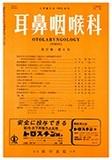Japanese
English
- 有料閲覧
- Abstract 文献概要
- 1ページ目 Look Inside
Ⅰ.はじめに
第1図の統計が示す如く,交通事故の発生件数は昭和34年頃をけい機として急激に増加し,昭和36年度は終戦直後の約50倍に達している。頭部外傷患者もこれと平行して増加し,特に近年頭部外傷による眩暈患者が多くなつている。
頭部外傷はその性質上,極めて複雑な病像を有し,単に脳外科のみならず精神科,眼科,耳鼻咽喉科,整形外科等多領域にまたがる事が多く,専門領域の異なる幾つかの科が相提携して,一人の患者を監視治療せねばならない事態がしばしば起きてくる。
Based upon their experience of 10 years in observing patients affected with vertigo caused primarily by head injuries, the authors attempted to make a classification of this affection, from the standpoint of otoneurology that would be conducive to methods of clinical treatments, dividing it into 5 follo-wing types:
1) Head injuries resulting immediate ves-tibular disturbances,
2) The latency in developing vestibular disturbance following a head injury, particu-larly the cervical vertigo types found in many cases,
3) Cases of head injuries presenting sym-ptoms of neurosis where no lesion is recog-nized either, functional or anatomical,
4) Cases of head injuries where cranial nerves appear to be anatomically intact yet, vestibular functional test would reveal some central disturbance,
5) Cases in whom the presence of central lesions are positive by both anatomical and functional examinations.

Copyright © 1965, Igaku-Shoin Ltd. All rights reserved.


